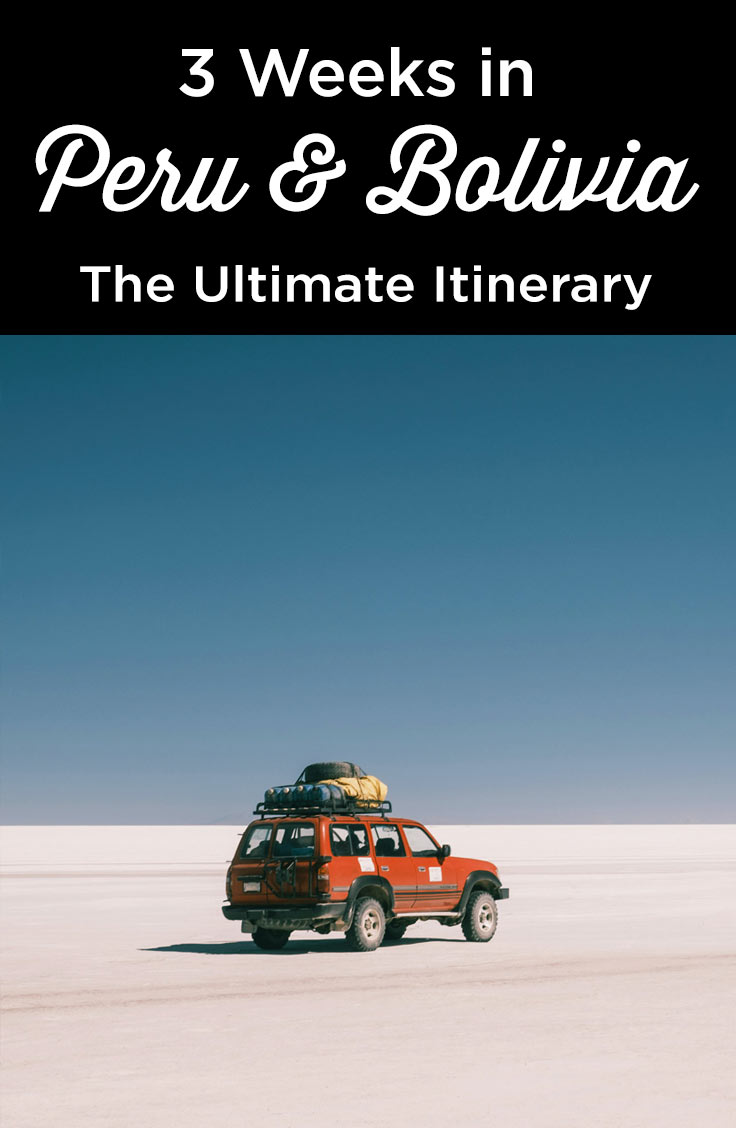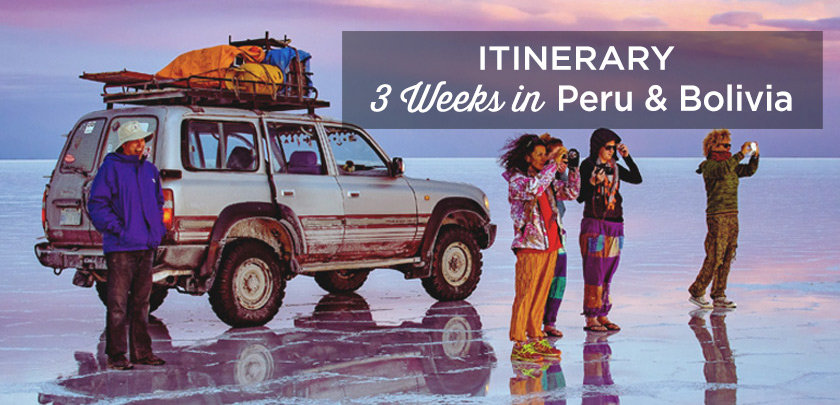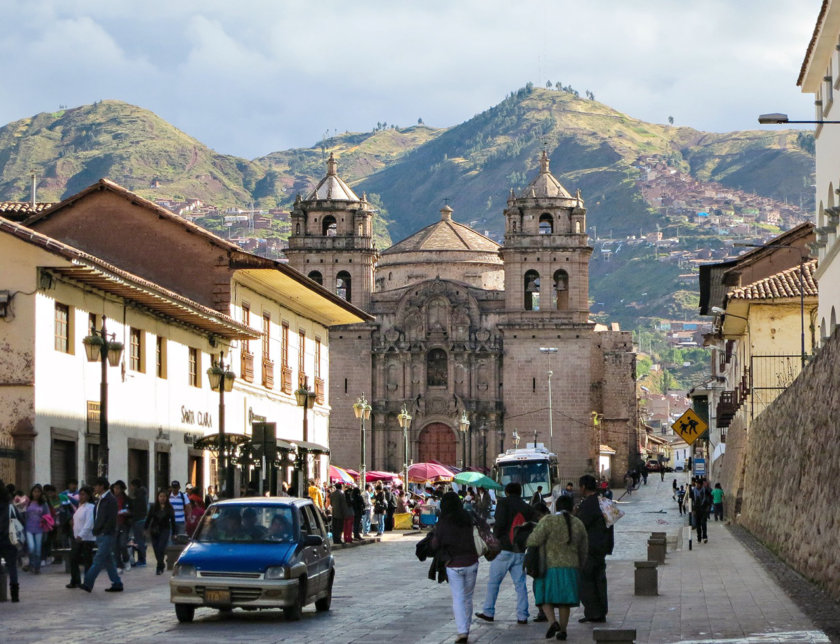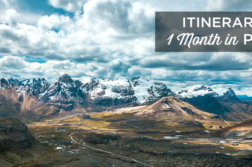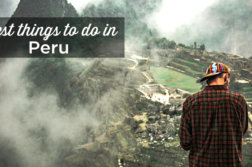The Ultimate 3-Week Itinerary in Peru and Bolivia
Planning a 3-week itinerary through Peru and Bolivia?
Great choice!
This route is packed with breathtaking landscapes, ancient history, and authentic local culture.
To help you organize your trip, I’ve put together a complete 21-day Peru-Bolivia itinerary that covers the most iconic highlights and practical travel tips along the way.
You’ll start in Lima, Peru’s vibrant capital, then make your way through the colonial charm of Arequipa and the majestic Colca Canyon, before heading to Cusco, the Sacred Valley, and the unforgettable Machu Picchu. From there, cross into Bolivia to discover the magic of Lake Titicaca, explore colorful La Paz, and end with the surreal beauty of the Salar de Uyuni and Sur Lípez.
Throughout this guide, I’ll share my top tips, route suggestions, and accommodation recommendations for every budget to help you make the most of your adventure—without feeling rushed.
So, how do you travel through Peru and Bolivia in 3 weeks?
Let’s dive in!
Sommaire
- The Ultimate 3-Week Itinerary in Peru and Bolivia
- Peru and Bolivia Itinerary
- 1) Lima (2 days)
- 2) Arequipa (1 day)
- 3) Colca Canyon (2-3 days )
- 4) Cusco (1-2 days)
- 5) The Sacred Valley (2-3 days)
- 6) Machu Picchu (1-2 days)
- 7) Lake Titicaca and Copacabana (2-3 days)
- 8) La Paz (2 days)
- 9) Salar de Uyuni and Sud Lipez (3 days)
- What is the best time to travel 3 weeks in Peru and Bolivia?
- How to handle altitude acclimatization during a trip to Peru and Bolivia?
- Book Your Flight at the Best Price
- Car Rental in Peru: My Top Recommendation
- Traveling to Peru? These articles will help you!
Peru and Bolivia Itinerary
1) Lima (2 days)
Lima, the capital of Peru, is the perfect starting point for any journey through Peru and Bolivia.
With a population of 10 million, this bustling city has plenty to offer across its diverse neighborhoods.
Day 1 – Exploring Lima
Start your adventure in two of the city’s most vibrant districts: Miraflores and Barranco.
Begin your day in Miraflores with a visit to Huaca Pucllana, a fascinating pre-Inca and Inca archaeological site that dates back over 1,500 years.
Then, take a walk along the Malecón, a scenic clifftop promenade overlooking the Pacific Ocean. You’ll enjoy breathtaking views of the coastline, surfers riding the waves, and lush green parks along the way.
Make a stop at the Parque del Amor, home to the famous sculpture “El Beso” by renowned Peruvian artist Víctor Delfín.
Continue to Larcomar, a shopping and entertainment center placed above the ocean, featuring boutiques, cafés, and restaurants with stunning terrace views.
From there, head down Avenida José Larco to Parque Kennedy, the heart of Miraflores. Nearby, explore the Surquillo Market, where you’ll find an incredible variety of local ingredients, from exotic fruits to Andean spices.
In the afternoon, make your way to Barranco, Lima’s most bohemian and artistic neighborhood.
Once a beachside retreat for Lima’s elite, Barranco still boasts beautifully preserved mansions, some of which have been converted into stunning venues like Hotel B on San Martín Street, the famous Ayahuasca Bar, and the elegant Victoria Bar.
Take a stroll to admire street art along Cajamarca Street and the Bajada de Baños, a charming path that leads all the way down to the beach.
Don’t miss the iconic Puente de los Suspiros—a must-visit for a great photo—before exploring the lively shops, cafés, and restaurants that line the walkway.
If you have extra time, consider visiting:
Pedro de Osma Museum – Housed in a grand mansion with lush gardens, this museum showcases an impressive collection of Peruvian art from the 16th to 19th centuries.
As night falls, Barranco comes alive with an amazing selection of bars and restaurants—making it the perfect spot for drinks and a great night out in Lima.
Day 2 – The Historic Heart of Lima
Now it’s time to explore the Historic Center of Lima, a must-visit on your 21-day road trip through Peru and Bolivia.
Morning in the Historic Center
Start your day at the Plaza de Armas, the heart of old Lima. Here, you’ll find stunning colonial and traditional buildings, including the Cathedral of Lima, the Archbishop’s Palace, and the Government Palace—where you can even catch the Changing of the Guard if you time it right.
Next, head to the San Francisco Monastery, home to a breathtaking Baroque basilica and the eerie catacombs, where thousands of bones rest beneath the city streets.
From there, take a stroll down Jirón de la Unión, a lively pedestrian street lined with historic landmarks, shops, and cafés. Along the way, stop to admire the Church of La Merced, an architectural gem dating back to the 16th century.
At the end of the street, you’ll arrive at the grand Plaza San Martín, a spacious square surrounded by elegant, early 20th-century buildings.
Right here, you’ll find the legendary Gran Hotel Bolívar, a historic landmark that was once the epitome of luxury in the 1920s. Step inside to admire its vintage charm, and if you’re feeling bold, head to the bar and order a pisco sour—or better yet, the Cathedral Pisco Sour, a double-strength version of Peru’s iconic cocktail!
Afternoon at the Larco Museum
In the afternoon, hop in a cab and head to the Larco Museum in the Pueblo Libre district. This museum houses an impressive collection of pre-Columbian artifacts, spanning 4,000 years of history. It’s widely regarded as one of the best museums in Latin America!
After your visit, take a moment to relax on the museum’s terrace café, where you can sip on a cocktail, enjoy a coffee, or even have lunch while surrounded by a gorgeous, flower-filled garden.
I invite you to consult my guides The 25 Best Things to See in Lima and What to Do and See in 2 Days in Lima with activities, itinararies and hotel recommendations to plan your visit.
Where to stay in Lima
For these two days, I recommend staying in Miraflores or Barranco, which are safe and well-located neighborhoods:
- Pariwana Hostel Lima: a very friendly youth hostel in the heart of Miraflores. Clean rooms, relaxed vibe, good Wi-Fi, with a restaurant, bar, and rooftop terrace. Dorm bed from only $13 USD and $50 USD for a private room!
- Casita Libertad Homestay: a small house located on a quiet and safe street in the Barranco neighborhood. Cozy atmosphere, very clean, with access to a fully equipped kitchen. Room from only $29 USD per night.
- Casa Andina: a 3-star hotel in Miraflores offering one of the best value-for-money stays in Lima. Modern hotel, recently renovated, with excellent service and an on-site restaurant. Buffet breakfast included, from $87 USD per night.
- Courtyard Lima Miraflores: a modern 4-star hotel perfectly located just steps from Kennedy Park. Comfortable and bright rooms, with a gym and a café-restaurant. From $165 USD per night.
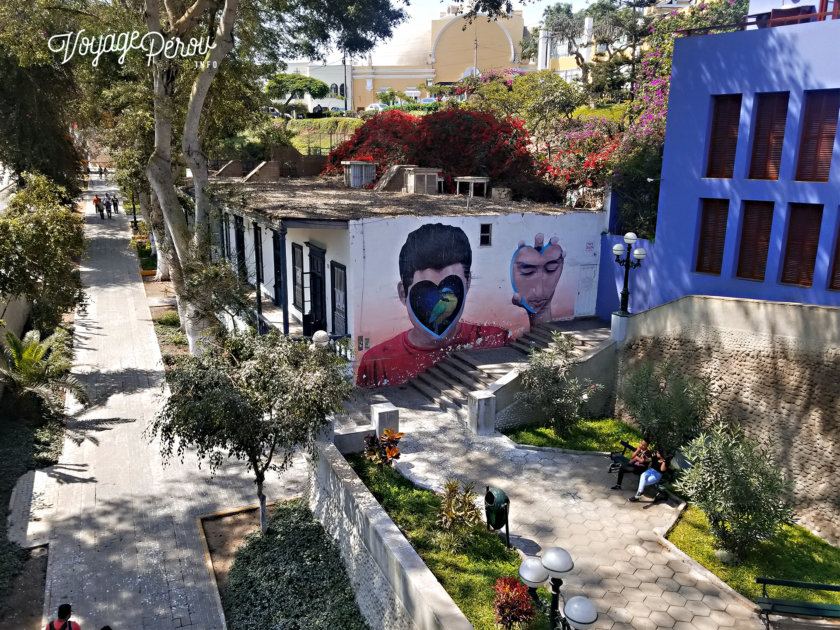
2) Arequipa (1 day)
I suggest you go to Arequipa, the second most important city in the country, located in the Andes at 7,660 feet altitude.
Much quieter than the capital, it is known as the “White City” for its buildings built with sillar, a white volcanic stone.
Start with the Plaza de Armas and its majestic neo-Renaissance cathedral. Climb the bell tower and you will have a wonderful perspective of the square and its surroundings.
You will also find the Church of the Company of Jesus and the Church of Our Lady of Mercy.
You can continue with a visit to the famous Santa Catalina Convent, a must on a 3-week road trip through Peru and Bolivia. Built in the 16th century, in its heyday it housed more than 450 cloistered Carmelite nuns.
Allow several hours to wander through its red and ochre-colored streets and discover its fascinating history.
On Tuesdays and Wednesdays it is open until 8:00 p.m., which will allow you to visit it at night, see its beautiful lights and its mystical side. I walked it at night and totally recommend it!
Finally, do not miss the beautiful traditional neighborhood of Yanahuara with its narrow streets.
Visit the Yanahuara viewpoint to admire the Misti, Pichu Pichu and Chachani volcanoes.
It is an ideal place to taste the cuisine of Arequipa as there are several traditional “picanterias”.
I invite you to read:
Go from Lima to Arequipa:
- By plane: 1h30 – Viva Air, Latam, Peruvian Airlines
- By bus: from 15h to 18h – Tepsa, Oltursa, Excluciva, Cruz del Sur, MovilTours
Where to stay in Arequipa
- Arequipay Hostel: Located a few blocks from the Main Square, this hostel offers very clean and bright dormitories. Perfect for budget travelers. Private rooms and shared dorms available. Basic breakfast served daily. From just $8 USD.
- Hotel Tierra Viva: Ideal for mid-range travelers. Just two blocks from the main square, it offers great value with comfortable rooms, Wi-Fi, and buffet breakfast included. From $60 USD per night.
- Hotel Los Tambos: A great choice for those seeking superior comfort. Located just 50 meters from the main square. Stylish rooms and a rooftop terrace with spectacular views of the city. À la carte breakfast with 5 menu options. From $71 USD per night.
- CIRQA – Relais & Châteaux: A stunning luxury hotel in the heart of Arequipa with a restaurant, bar, and rooftop terrace. Breakfast and dinner included with all rooms. From $475 USD per night.
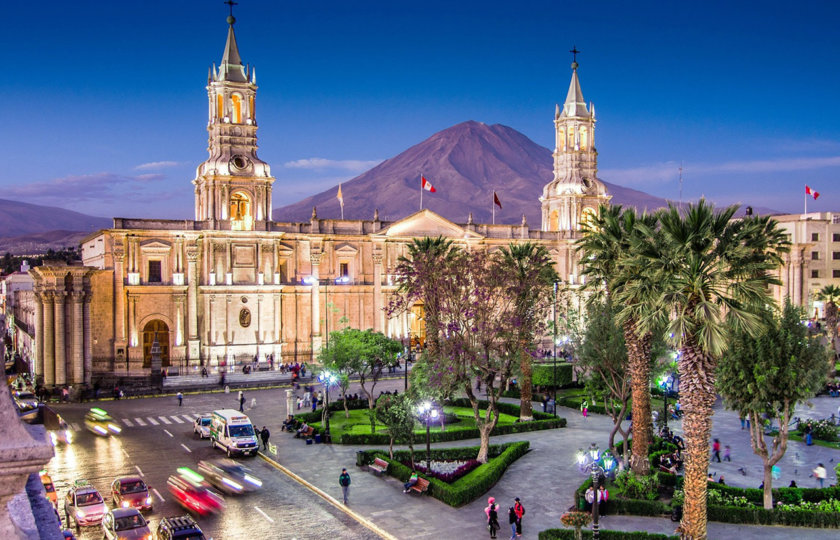
3) Colca Canyon (2-3 days )
Located in the Arequipa region, the Colca Canyon is also another must-see during a 3-week tour of Peru and Bolivia.
Long considered the deepest canyon in the world, it was dethroned by its neighbor, the Cotahuasi Canyon.
However, with its 11,150 feet deep, it is still very impressive.
Besides marveling with the fabulous landscapes, you must go to the Cruz del Condor, an exceptional viewpoint to observe the condor of the Andes in full flight!
This is the program of a 2 days tour in the Colca Canyon:
- Departure from your hotel in Arequipa: you will pass through Pampa Cañahuas in the Aguada Blanca National Reserve where you will find lamas, alpacas and vicuñas.
- Photo stops at the Mirador de los Andes, Chucura crater and Mirador Chivay.
- Arrival to Chivay around 13h, you can have lunch and settle in the hotel
- Then you will have the option to go to the hot springs of La Calera or enjoy your free time
- In the evening, you will attend a dinner with a folkloric, music and dance show.
- The next day, visit the Cruz del Condor and the town of Yanque,
- Viewpoints Choquetipo y Artahuilque where you can see pre-Inca tombs and magnificent terraced crops.
- Return to Arequipa around 17h30
You can book here the tour which includes pick up at your hotel in Arequipa, entrance fees at the Colca, stops at the main attractions of the canyon:
- If you like trekking, you can also book the 2 Days Trek to the Colca or the 3 Days Trekk to the Colca Canyon with transportation from Arequipa, guide, meals and lodging!
- If you prefer to go on your own, I recommend you to read my Complete Article about the Colca Canyon so you can have all the practical information to set up your trip.
Going from Arequipa to the Colca Canyon
- By tourist van: the departure is from your hotel in Arequipa, early in the morning (3h). The arrival in Chivay is around 6h, then the stop at the Cruz del Condor around 8h, before arriving in Cabanaconde at 10h.
- By local bus: the trip takes 4h to Chivay, or 6h to Cabanaconde. Departure from the terminal of Arequipa with the company Andalucía.
Where to Stay in the Colca Canyon
- Paraiso Las Palmeras: the best option in Sangalle Oasis! The perfect place to relax during the Colca Canyon trek, with a pool surrounded by lush vegetation, an on-site restaurant, and good Wi-Fi. Breakfast included, from just $26 USD for a double room with private bathroom.
- La Granja del Colca: A true gem in Cabanaconde! Perched on a cliff, this hotel offers amazing views of the canyon—even from your room—and it’s one of the best spots to see condors in the morning. There are also friendly llamas in the garden. Fantastic value for money, from just $52 USD per night.
- Casa Andina Classic Colca: For a more comfortable stay in the Colca Valley, this charming rustic hotel in Chivay offers bungalows set in beautiful gardens. There’s also a great restaurant, breakfast buffet, spa, and even a telescope to admire the southern sky. From $72 USD per night.
- Colca Lodge Spa & Hot Springs: The perfect choice for a romantic stay in the Colca Valley. With direct access to natural hot springs, a spa, restaurant, and bar, this hotel features stylish rustic rooms with garden views. From $164 USD per night.

4) Cusco (1-2 days)
Now it is time to discover the famous capital of the Incas: Cusco!
At 11,150 feet of altitude, it is a city full of history that can be easily discovered by foot. It is certainly the best way to know the beauty of its architecture, a mixture of Inca alleys and colonial buildings.
The ideal would be to visit Cusco in 2 or 3 Days, although it would be possible to do it in 1 day.
If you don’t have it, they won’t let you pass. You can buy it here: 1st day -In the morning we start the sightseeing by the Plaza de Armas, the center of the city. The cathedral and the Iglesia de la Compañía are emblematic places to be admired, as well as the colonial buildings. Visit San Blas, the artists’ quarter of Cusco. You will find streets with lots of charm, restaurants, art galleries, boutiques, etc. I recommend you to follow this route: Stroll around San Blas, the streets have a lot of charm. There are also a lot of nice restaurants, it is an ideal place to eat or have a drink. 2nd day- In the morning, start with a visit to the Coricancha. The Temple of the Sun, dedicated to the god “Inti”, was the most sacred place of the Inca Empire and was decorated with fine gold leaf. It´s here where the sovereigns paid homage to them and where their mummies were preserved. It was destroyed by the conquistadors who built on top of this place, the convent of Santo Domingo in 1534. Then go to the San Pedro Market. You will see a great variety of potatoes, quinoa and other Andean cereals, fruits, vegetables and cheeses. In the afternoon, visit the 4 archaeological sites very close to Cuzco: If you have little time and want to make the most of Cusco, I recommend this guided tour of the historic center of Cusco. It also includes the 4 Inca archaeological sites and pick up from your hotel. Book it here: You can also read: Going from Arequipa to Cusco: Where to Stay in Cusco The Sacred Valley is a fundamental visit of a 20-21 day itinerary in Peru and Bolivia as there is a lot to do. With a good organization, you will be able to visit the most important sites in 2 days. 1st Day – Start with Pisac and Ollantaytambo, the two most important Inca archaeological sites in the Sacred Valley. Then, visit the village of Chinchero, with small cobblestone streets and white houses. It is known for its textile art. It is the ideal place to discover the process of its manufacture, the spinning, how it is woven, the nautral dyes. You will find in the market tapestries and handmade clothes, the prices are better than in other places. If you want to see the most of the Sacred Valley in a short time, without wasting time in transportation, I suggest you to take a tour from Cusco. I recommend this tour of Pisac, Ollantaytambo and Chinchero, with lunch included: Day 2 – Today discover Maras and Moray. Take the road to the site of the Salineras de Maras, one of the most impressive areas in the region! Here, a spring of salt-rich water pours into more than 3,000 ponds, which offer a stunning view, all in white, like something out of a fairy tale. Some 800 families run these ponds as a cooperative and produce an average of 180 tons of salt per year. Not far from there is Moray, an ancient Inca agricultural research center. Here we find different circular terraces built to create about twenty microclimates. The temperature variation between the center and the extremities has allowed to carry out different experiments and to cultivate numerous exotic species. I recommend this tour of the salt mines of Maras and the terraces of Moray: Day 3– If you prefer to give yourself more time in the valley and spend 3 days instead of 2 days, I recommend that you concentrate on Ollantaytambo since besides being extremely pleasant to walk around the area it has lots of free and interesting attractions. You could also spend the night here before going to Machu Picchu as there is a train station. The best, of course, is its fortress, which also offers a magnificent panoramic view of the surrounding area. Where to Stay in Ollantaytambo This is the most awaited moment of a 3-week tour of Peru and Bolivia: Machu Picchu, one of the 7 new wonders of the world! Abandoned after the fall of the mighty Inca empire in the 16th century, the site was unveiled by Hiram Bingham in 1911. It seems that Machu Picchu had a dual vocation: residential (for the elite) and religious. It was really a small city, with houses, its temple, its squares, its agricultural area. Machu Picchu is located between two mountains, at 8,000 feet of altitude: the Huayna Picchu (the young mountain) and the Machu Picchu (the old mountain). If you wish to take a guided tour of Machu Picchu, you will easily find guides offering their services in different languages at the entrance of the site. It is very important to book your tickets to Machu Picchu in advance: To choose which type of ticket suits you, I invite you to read: Huayna Picchu and Machu Picchu Mountain: Which Are the Differences? Getting to Machu Picchu: Option 1: train – 3h from Cusco or 1h30 from Ollantaytambo. It is the fastest way to get there and the scenery is really amazing but I recommend that you book your train tickets to Aguas Calientes in advance, to make sure you can get on the train at the time that suits you. You can buy your train tickets to Aguas Calientes from Cusco or Ollantaytambo here: Option 2: trek to Machu Picchu – although remember that the only one that goes directly to Machu Picchu is the Inca Trail, while the others go through Aguas Calientes. You can book your trek here: Option 3 – by bus and walking – the most economical and the longest way You have to take a colectivo from Cusco to Hidroeléctrica (7h) and walk to Aguas Calientes (2h30-3h) And remember that when you arrive in Aguas Calientes, you will have to take the bus up to Machu Picchu (20 min).You can book your bus tickets here: Where to Stay in Aguas Calientes (Machu Picchu Pueblo) Now let’s visit the highest navigable lake in the world: Lake Titicaca, at 12,470 feet above sea level As you are lucky enough to visit Peru and Bolivia for 21 days, I advise you to give priority to the Bolivian side as the city of Copacabana is much nicer than Puno. It is recommended to visit it from Bolivia and not from Peru since the Bolivian city of Copacabana is a place with a lot of charm unlike Puno in Peru. Besides the Isla del Sol is a true jewel. Day 1 – First discover Copacabana, which means in Quechua “view over the lake”. It is a small, beautiful and quiet city, that thrives outta tourism. You will be pleased to rest here after the Machu Picchu stage. Visit its great Cathedral, all white and beautiful and if you can, try the trout that comes directly from the lake. In the afternoon, I strongly advise you to go see the sunset from the viewpoint located on Mount Calvario: you will have a view over the immensity of the lake, and the sunset offers amazing colors over the city and magical reflections on the water. Go from Cusco to Puno, and then Copacabana: 2nd day- The next day, early in the morning, head to the port to buy the ticket, for the lake crossing to Isla del Sol. You can reach the island either north to the town of Challapampa or south to the town of Yumani. I advise you to arrive in Challapampa and then walk south and depart from Yumani. If you would like to leave in the afternoon, boats leave later on the south side to return to Copacabana. Here are the boat schedules (to be confirmed on the spot): – Departure from Copacabana: 8h30 or 13h30 to Challapampa or Yumani – Return from Challapampa: 8:30 am, 10:30 am and 1:30 pm – Return from Yumani: 8:30 am, 10:30 am and 4:30 pm The crossing costs approximately 30 bolivianos (3 euros). It is necessary to have some coins because on the island, there are some toll points where you have to pay. Keep your tickets well because you might be asked for them again on the way (each toll costs about 10 bolivianos). It all depends on the trail you take and the archaeological sites you wish to see, there can be up to three tolls. It is a way to contribute to the communities to keep the roads in good condition and keep the island clean. As soon as you arrive, you can choose to cross the island in two ways: either the crete trail or the beach trail. Since I only stayed for one day, I couldn’t do the outward journey on one trail and the return on the other. The path of the hills allowed me to have a panoramic view of the island. You cannot believe that it is a lake, because it is immense! It´s true that at certain times of the year there may be more travelers on the trails, but when I went in April, I felt alone in the world. To discover on the island: Chinkana, Challa and also the Pilkokaina Palace. Where to Stay in Copacabana The next stop of this 3-week stay in Peru and Bolivia: La Paz (12,000 feet altitude), the capital of Bolivia and the highest capital in the world. With a 3,280 feet difference in altitude between the wealthy neighborhoods and the poor neighborhoods, you will have to make a lot of effort with your legs as its streets are very steep. Fortunately it has a well-developed urban cable car (the longest and highest in the world!). Day 1 – Visit the city of La Paz Discover the Mercado Rodriguez, also the famous Mercado de las brujas where there are all kinds of magic potions, then to the Plaza Murillo and the cathedral of San Francisco. Then you could go to the Mirador Kili Kili to have a panoramic view of the city. If you are “foodie”, I suggest you take this Gastronomic Tour of La Paz in the afternoon with a guide who will make you discover the local specialties. 2nd Day- If you like adventure and adrenaline, I propose you to make the descent of the famous Ruta de la Muerte by mountain bike. It´s such an unforgettable experience! Choose your agency well, as it is essential that you get good equipment and bikes in good condition. You can book the Death Road tour with a well-established agency here: If you had time left, you could go see a Cholitas Wrestling show. It’s a cholitas wrestling match, those Bolivian wrestlers who are characterized by wearing traditional dress. Go from Copacabana to La Paz: Where to Stay in La Paz One of my favorite moments of this 3-week trip through Peru and Bolivia was to discover the Salar de Uyuni and Sud Lipez. The departure can be made from the cities of Uyuni or Tupiza, the latter is located further south. I recommend you to leave from Uyuni. The classic circuit to visit the Salar de Uyuni is 3 days with full board (transport, meals, lodging). Don’t forget to bring warm clothes, thick wool socks and a sleeping bag to protect you from the extreme temperatures, even if you are lodged, the accommodations are quite basic, there is no heating and you will climb to 16,400 feet of altitude! 1st Day – Departure to the Salar de Uyuni at around 10:30 am. You will first head to the train cemetery to take some photos of locomotive and wagon skeletons, then visit the Colchani salt museum, before arriving at the famous salt desert. During the rainy season, the desert is covered with a thin layer of water, and gives the impression of walking on a huge mirror. Take the opportunity to take original photos playing with perspective. You will be taken to the Incahuasi island or cactus island. In the middle of the desert, it is a mini hill covered with cactus. At night you will sleep in a salt hotel, basic but good! 2nd Day- You will discover, some lagoons, the Árbol de Piedra (stone tree) in the middle of a lunar landscape of the Dali desert. You will arrive at the Laguna Colorada, with an ecosystem of great biological diversity, it is the ideal habitat for nesting Andean flamingos. Day 3– On the last day, you will head to the hot springs, discover geysers, and finally the Laguna Verde at the foot of the Licancabur volcano – where sacrifices were made. These will be intense days, both for the physical effort (cold, high altitude, getting up early) and for the beauty and diversity of the landscape. You will return to Uyani, and from there to La Paz to take your flight back. You can book the 3 days trip to the Salar de Uyuni with a serious agency here: You will travel from La Paz to Uyuni: Where to Stay in Uyuni If you want to make the most of your 3-week itinerary in Peru and Bolivia, choosing the right season is essential. This route crosses diverse regions—deserts, high mountains, and jungle—so climate plays a big role. Dry season (May to October) – The best time to go I highly recommend planning your trip between May and October. It’s the best time for clear skies, dry trails, and stunning views at Machu Picchu, Lake Titicaca, and the Salar de Uyuni. Keep in mind: Rainy season (November to April) – Not ideal for this itinerary Traveling from January to March means frequent rain, especially in the Andes. It’s not impossible, but some places may become inaccessible or affected by bad weather. Pros: The Uyuni Salt Flats turn into a giant mirror — breathtaking for photographers. Cons: So, when should you go? The best time for this Peru and Bolivia 3-week itinerary is definitely May to October, when you can travel worry-free and enjoy every destination in its best condition. As an alternative, the shoulder months—late April or early November—can offer fewer crowds and greener landscapes in the Sacred Valley, with relatively low rain risk. Altitude can be a challenge in places like Cusco, Puno, La Paz, or Uyuni. Everyone reacts differently, but it’s best to prepare and take it easy. I always take some basic precautions when traveling at altitude. Here are my go-to tips to avoid altitude sickness on this itinerary: This itinerary is designed with a gradual ascent to help your body adapt. You should be fine, but always listen to your body and take breaks when needed. Planning a trip to Peru? To get the best deal on your flights, I recommend using this flight comparison tool, in partnership with Skyscanner. It’s the easiest way to find the lowest prices for both international flights and domestic flights within Peru—ensuring you pay the best rate with no hassle! Thinking about renting a car in Peru? Great idea! It’s one of the best ways to explore Peru freely and access destinations that are off the beaten path—especially if you’re planning to visit remote areas like the Sacred Valley, Huaraz, or the coast near Paracas. Personally, I always use Booking.com Cars to rent a car in Peru, and here’s why I keep coming back: Click the button below to check current car rental deals in Peru and book with confidence: Discover all my articles about Peru: All my tips and itineraries to plan your trip in one place! 40 EPIC Things to Do in Peru (+ My Best Tips)

5) The Sacred Valley (2-3 days)
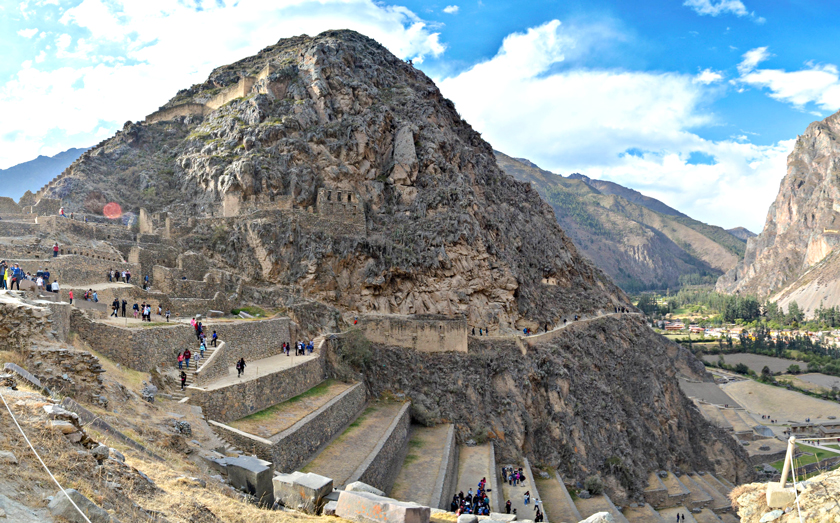
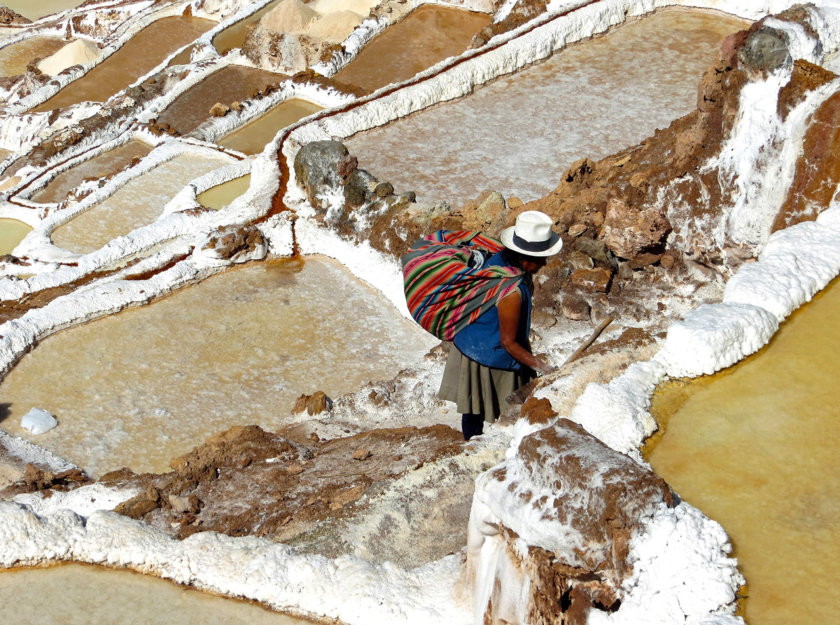
6) Machu Picchu (1-2 days)
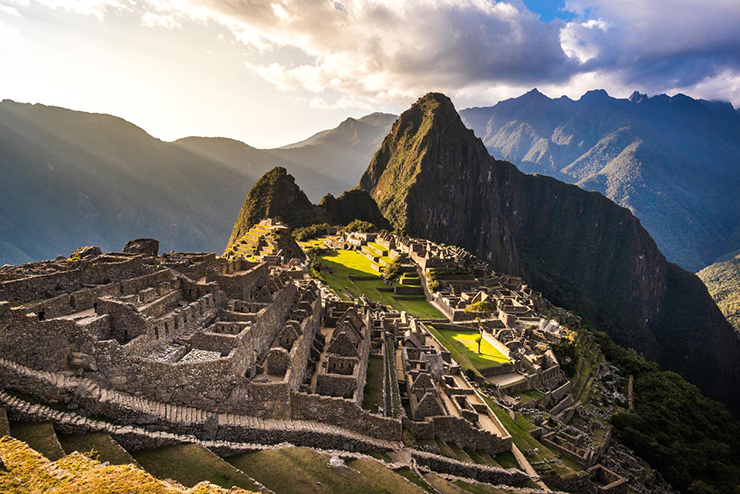
7) Lake Titicaca and Copacabana (2-3 days)
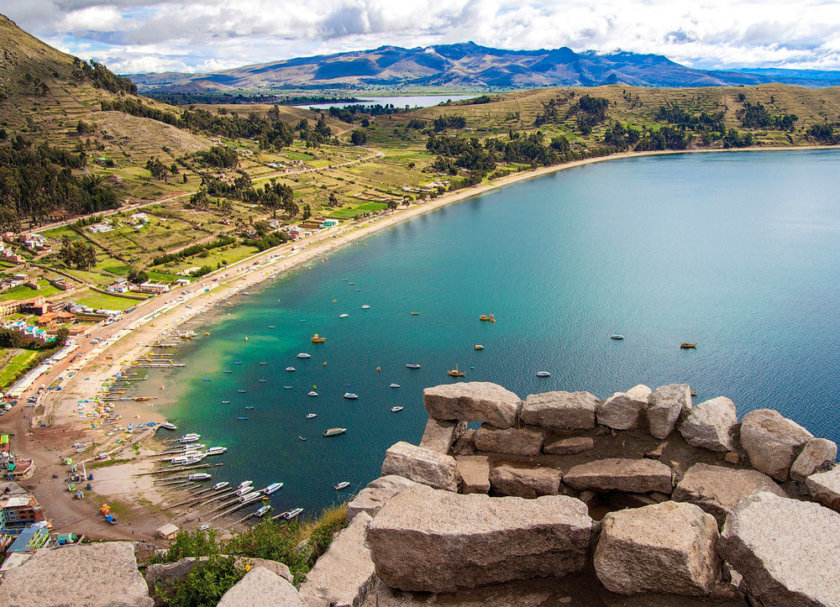
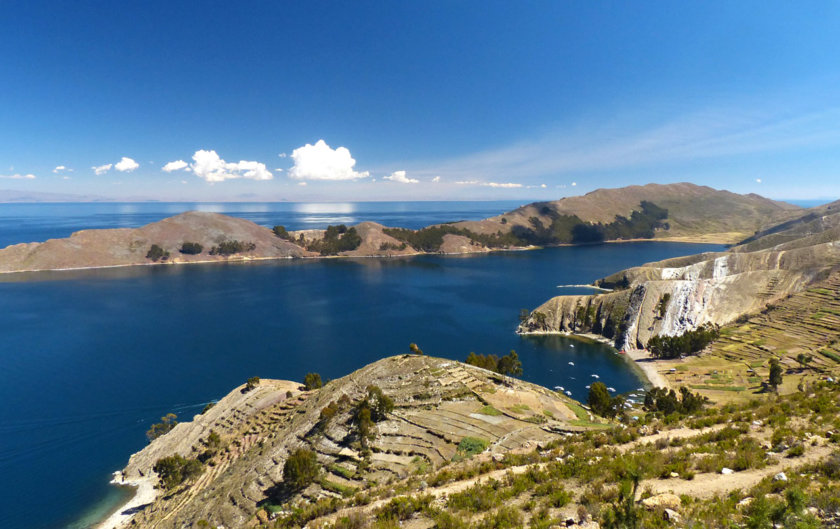
8) La Paz (2 days)
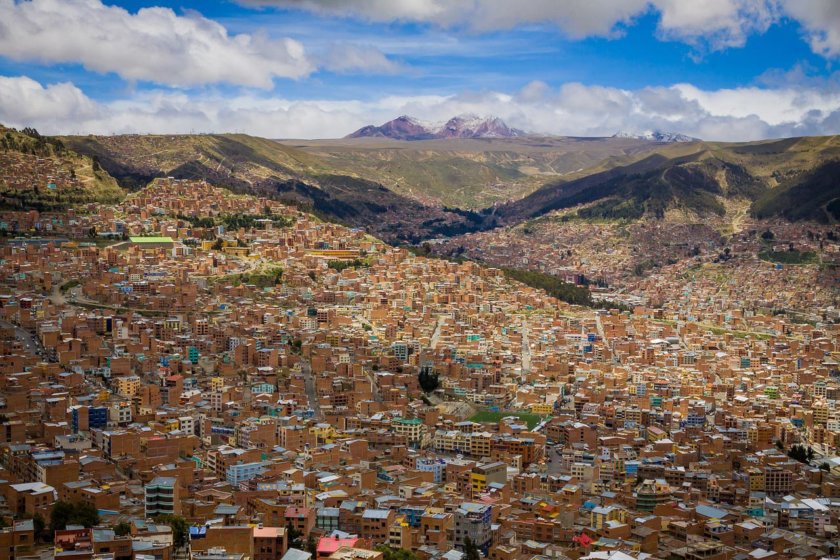
9) Salar de Uyuni and Sud Lipez (3 days)
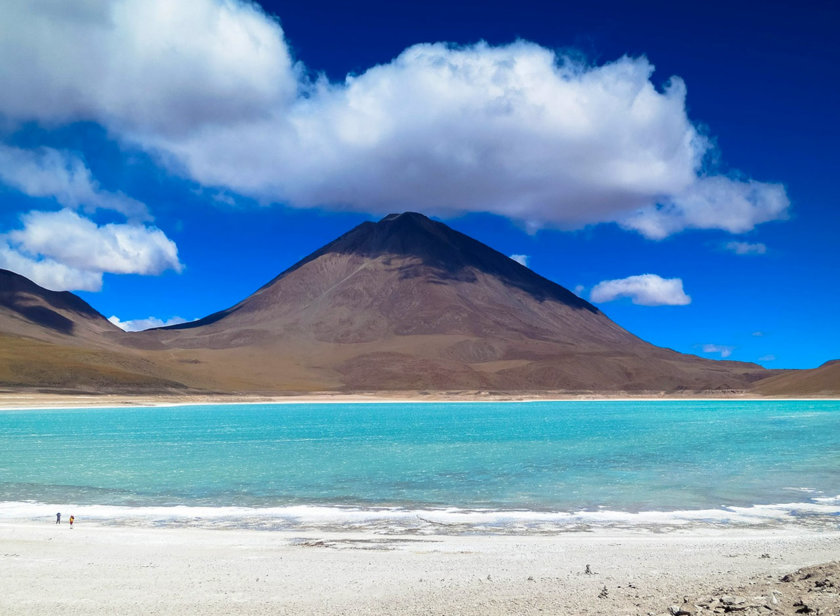
What is the best time to travel 3 weeks in Peru and Bolivia?
How to handle altitude acclimatization during a trip to Peru and Bolivia?
Book Your Flight at the Best Price
Car Rental in Peru: My Top Recommendation
Rent a car
Book entrance tickets and guided visits
Take a travel insurance
Book a tour
✈️ Book your flightTraveling to Peru? These articles will help you!
You’re using Pinterest? Here is the picture to pin!
